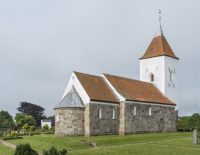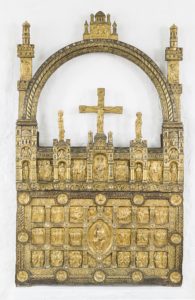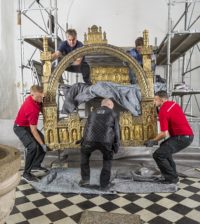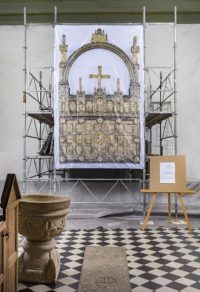 Sahl Church in the Northwest Jutland village of Sahl near Struer is a fine example of Romanesque architecture. Built around 1150 out of granite ashlars, it has several notable features: a rune stone built into the chapel’s west wall, 16th century frescos, a burgundy silk velvet chasuble embroidered with silver thread made from the wedding dress of Queen Anna Sophia that is still used today on special occasions. Its most spectacular feature is the Golden Altar, a gilded copper altarpiece made by a Danish master artisan from Ribe in around 1200. Embedded with crystals around the borders, the reliefs on the altarpiece panels depict figures and scenes from the Bible, particularly the childhood and suffering of Jesus, and Christian symbolism.
Sahl Church in the Northwest Jutland village of Sahl near Struer is a fine example of Romanesque architecture. Built around 1150 out of granite ashlars, it has several notable features: a rune stone built into the chapel’s west wall, 16th century frescos, a burgundy silk velvet chasuble embroidered with silver thread made from the wedding dress of Queen Anna Sophia that is still used today on special occasions. Its most spectacular feature is the Golden Altar, a gilded copper altarpiece made by a Danish master artisan from Ribe in around 1200. Embedded with crystals around the borders, the reliefs on the altarpiece panels depict figures and scenes from the Bible, particularly the childhood and suffering of Jesus, and Christian symbolism.
 Popular devotional objects in the Middle Ages, only seven golden altars remain today in Denmark and only two of them in their original locations. (The rest are kept at the National Museum.) The bursts of iconoclastic zeal and the preference for plain church decor of the Reformation took a heavy toll on these objects. Many of them were destroyed and the ones that remain are not in the best of the condition. The altarpiece of Sahl Church is by far the best preserved of the seven, largely intact with no major missing parts. Most of the crystals were lost by the 1930s, but they were restored by National Museum experts in 1935.
Popular devotional objects in the Middle Ages, only seven golden altars remain today in Denmark and only two of them in their original locations. (The rest are kept at the National Museum.) The bursts of iconoclastic zeal and the preference for plain church decor of the Reformation took a heavy toll on these objects. Many of them were destroyed and the ones that remain are not in the best of the condition. The altarpiece of Sahl Church is by far the best preserved of the seven, largely intact with no major missing parts. Most of the crystals were lost by the 1930s, but they were restored by National Museum experts in 1935.
In 1850, Jens Jacob Asmussen Worsaae, an archaeologist who was Denmark’s Inspector for the Conservation of Antiquarian Monument, surveyed the church as part of an inspection tour of the area. He warned in a letter that Sahl’s vicar was “adamant that the strange old altarpiece was to be removed” and when he wasn’t able to get rid of the priceless medieval gold and crystal altarpiece, he hired a local artist to paint over the wings. They weren’t original to the piece, thankfully, and they’re gone now but it lends some insight into why there are so few of these inestimable treasures left. Changes in fashion and taste can wreak havoc on historic artifacts, even ones whose value in sheer materials is blatantly obvious. This same vicar, by the way, also had the church’s medieval wooden coffer axed to pieces FOR FIREWOOD. Yet another page in the endless People Are Terrible ledger.
 The altar has not been absolutely dated. What we know of their ages has been deduced from analysis of the design style and craftsmanship. When it was last restored more than 80 years ago, it was only spruced up. A new study of the Sahl Golden Altar by conservators at the National Museum of Denmark will give experts the opportunity to use modern methods of analysis to test the wood itself. Dendrochronology, if successful, can provide very precise dates. It will also be X-rayed and the gilding analyzed. They hope the study will reveal more information about the altar’s construction and materials.
The altar has not been absolutely dated. What we know of their ages has been deduced from analysis of the design style and craftsmanship. When it was last restored more than 80 years ago, it was only spruced up. A new study of the Sahl Golden Altar by conservators at the National Museum of Denmark will give experts the opportunity to use modern methods of analysis to test the wood itself. Dendrochronology, if successful, can provide very precise dates. It will also be X-rayed and the gilding analyzed. They hope the study will reveal more information about the altar’s construction and materials.
 While the altar is at the museum, visitors to Sahl Church will see a large-scale photograph of it draped over its usual location.
While the altar is at the museum, visitors to Sahl Church will see a large-scale photograph of it draped over its usual location.
Within the last few years, the National Museum has conducted further studies on several of the golden altars. The results from this will be gathered in a publication about the unique cultural heritage of golden altars from the Middle Ages, which exists in Denmark.
It is the Carlsberg Foundation, which has granted the money for analyzes of the alhl from Sahl, and the experts hope that the results will be available at the end of the year.
In addition to a new study of the altar, the church itself will also be thoroughly reviewed. This appears in a publication published in the beginning of 2018, where the churches in Estvad, Rønbjerg and Vinderup will also be described.
The publication of the four Western Jutland churches is published as a volume in the National Museum’s great work of Danish Churches, which aims to publish descriptions of all the churches of the country. The project started in 1933, and today about two thirds of the Danish churches are described.